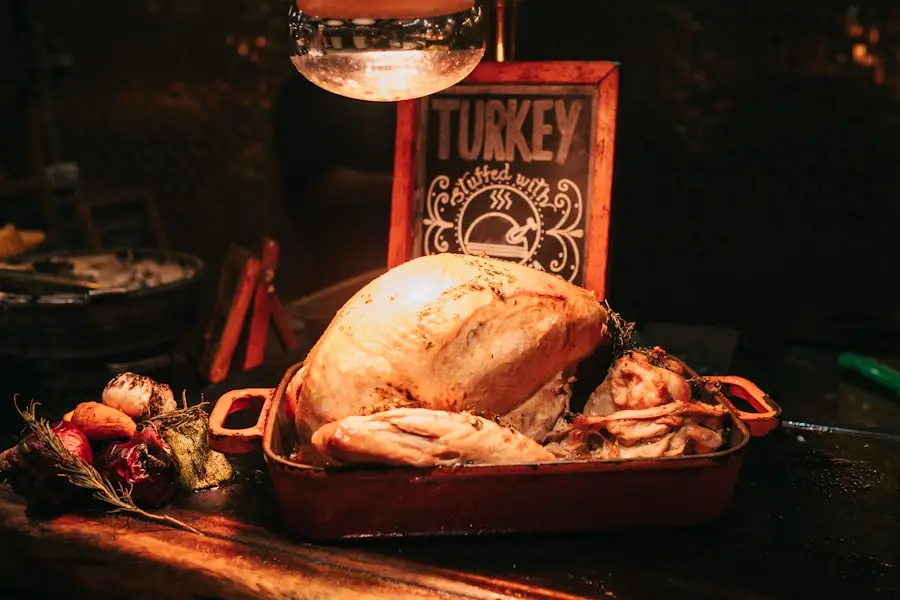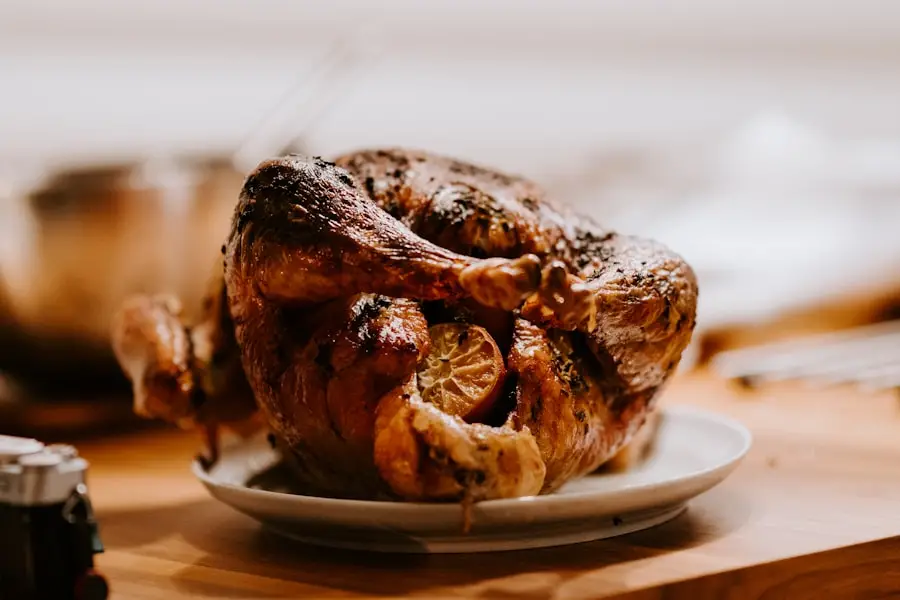When it comes to selecting the perfect turkey, the options can be overwhelming. The first step is to determine the size of the turkey you need, which largely depends on the number of guests you plan to serve. A general rule of thumb is to allow around 1.5 pounds of turkey per person.
This means that for a gathering of eight people, a turkey weighing around 12 pounds should suffice. However, if you want leftovers (and who doesn’t?), consider opting for a larger bird. Next, you’ll want to decide between a fresh or frozen turkey.
Fresh turkeys are often more succulent and flavourful, but they require careful planning as they have a shorter shelf life. On the other hand, frozen turkeys can be stored for longer periods, but they need ample time to thaw before cooking. Whichever option you choose, ensure that the turkey is of high quality.
Look for birds that are labelled as free-range or organic, as these tend to have better flavour and texture due to their natural diets and living conditions.
Summary
- Choose a fresh or properly thawed turkey of suitable size for your gathering.
- Prepare the bird by cleaning and patting it dry before seasoning.
- Use a blend of herbs, spices, and butter to enhance flavour.
- Roast at the correct temperature, basting regularly to keep the meat moist.
- Allow the turkey to rest before carving to retain juices and ensure tenderness.
Preparing the Turkey for Roasting
Once you’ve selected your turkey, it’s time to prepare it for roasting. Start by removing the turkey from its packaging and taking out any giblets or neck that may be tucked inside the cavity. These can be saved for making a rich gravy later on, so don’t discard them just yet!
Rinse the turkey under cold water and pat it dry with paper towels. This step is crucial as it helps achieve that coveted crispy skin during roasting. Next, consider brining your turkey for added moisture and flavour.
A simple brine can be made with water, salt, sugar, and various herbs and spices. Submerge the turkey in the brine solution for several hours or overnight in the fridge. If you’re short on time, a dry brine—where you rub salt and seasonings directly onto the skin—can also work wonders.
Whichever method you choose, ensure that your turkey is well-prepared before it hits the oven.
Seasoning and Flavoring the Turkey

Seasoning is where you can truly let your culinary creativity shine. While salt and pepper are essential, don’t shy away from experimenting with various herbs and spices to elevate your turkey’s flavour profile. Classic choices include thyme, rosemary, and sage, which pair beautifully with poultry.
You might also consider adding garlic powder or onion powder for an extra depth of flavour. In addition to dry seasonings, consider using a compound butter to slather under the skin of your turkey. This mixture can include softened butter combined with minced garlic, fresh herbs, lemon zest, and even a hint of Dijon mustard for a tangy kick.
By applying this buttery concoction directly onto the meat, you’ll not only enhance the flavour but also help keep the turkey moist during roasting.
Roasting the Turkey to Perfection
Roasting a turkey is both an art and a science. Preheat your oven to 180°C (350°F) and place your seasoned turkey on a roasting rack in a large roasting pan. This allows hot air to circulate around the bird, ensuring even cooking.
It’s advisable to cover the turkey loosely with foil for the first part of the cooking process to prevent over-browning while allowing it to cook through. The general cooking time for a turkey is about 13 minutes per pound if unstuffed, or 15 minutes per pound if stuffed. However, every oven is different, so it’s wise to keep an eye on your bird as it roasts.
You’ll know it’s time to remove the foil when the skin turns a beautiful golden brown. This is also when you can start basting your turkey for added moisture and flavour.
Basting and Moisturizing the Turkey
Basting is an age-old technique that involves spooning or brushing pan juices over the turkey as it roasts. This not only helps keep the meat moist but also enhances the flavour of the skin. Aim to baste your turkey every 30 minutes or so after removing the foil cover.
If you’ve made a compound butter, consider melting some of it and using it for basting; this will add an extra layer of richness. While basting is beneficial, be cautious not to open the oven door too frequently as this can lower the temperature inside and prolong cooking time. Instead, try to work quickly when basting to maintain an even cooking environment.
If you notice that your turkey is browning too quickly, you can always cover it loosely with foil again until it’s fully cooked.
Checking the Turkey for Doneness

Determining when your turkey is fully cooked is crucial for both safety and taste. The best way to check for doneness is by using a meat thermometer inserted into the thickest part of the thigh without touching bone; it should read at least 75°C (165°F). If you’re cooking a stuffed turkey, ensure that the centre of the stuffing also reaches this temperature.
Another indicator of doneness is the juices that run from the turkey when pierced; they should run clear rather than pink. Additionally, if you gently wiggle the leg and it moves easily at the joint, this is another sign that your turkey is ready to come out of the oven. Once you’ve confirmed that your bird is cooked through, resist the urge to carve it immediately; resting is key.
Resting and Carving the Turkey
Resting your turkey after roasting is an essential step that many home cooks overlook. Allowing it to rest for at least 20-30 minutes before carving lets the juices redistribute throughout the meat, resulting in a more succulent final product. Tent your turkey loosely with foil during this time to keep it warm while preventing it from cooling down too much.
When it comes time to carve your turkey, use a sharp carving knife for clean slices. Start by removing the legs and thighs first; simply cut through the joint where they connect to the body. Next, slice down along either side of the breastbone to remove the breast meat in large pieces.
Finally, cut these pieces into thinner slices for serving. Remember to save any leftover meat for sandwiches or soups!
Serving and Enjoying the Perfectly Roasted Turkey
Now that you’ve successfully roasted and carved your turkey, it’s time to serve up this culinary masterpiece! Arrange slices on a large platter alongside traditional accompaniments such as stuffing, cranberry sauce, and roasted vegetables. A beautiful presentation will not only impress your guests but also enhance their dining experience.
As everyone gathers around the table, take a moment to appreciate all your hard work in preparing this delicious meal. The aroma of roasted turkey wafting through your home creates an inviting atmosphere that brings people together. Enjoy each bite and relish in the joy of sharing good food with loved ones—after all, that’s what cooking is all about!
Whether it’s a festive occasion or a simple family gathering, a perfectly roasted turkey will always be a highlight on any dining table.
FAQs
What is the best way to ensure a roast turkey stays moist?
To keep a roast turkey moist, it is important to brine the bird beforehand or baste it regularly during cooking. Using a meat thermometer to avoid overcooking and resting the turkey after roasting also helps retain moisture.
Should I brine my turkey before roasting?
Brining your turkey, either in a wet or dry brine, helps to enhance flavour and moisture retention. It is recommended to brine the turkey for at least 12 to 24 hours before cooking.
How long should I cook a turkey for Christmas dinner?
Cooking times vary depending on the weight of the turkey. As a general guide, roast the turkey at 180°C (fan 160°C) for about 20 minutes per 500g, plus an additional 70 minutes. Always check the internal temperature to ensure it is fully cooked.
What internal temperature should a roast turkey reach?
The internal temperature of the turkey should reach 75°C in the thickest part of the breast and 80°C in the thickest part of the thigh to be safe to eat.
Is it better to cook the turkey covered or uncovered?
Cooking the turkey uncovered helps to achieve crispy skin, but covering it with foil partway through cooking can prevent the breast from drying out. Many cooks cover the breast with foil after the first hour of roasting.
How long should I rest the turkey after roasting?
Rest the turkey for at least 20 to 30 minutes after roasting. This allows the juices to redistribute throughout the meat, resulting in a juicier bird.
Can I stuff the turkey before roasting?
You can stuff the turkey, but it is important to ensure the stuffing reaches a safe temperature of 75°C. Alternatively, cook the stuffing separately to avoid uneven cooking.
What type of fat or butter should I use to baste the turkey?
Many cooks use melted butter, olive oil, or a mixture of herbs and fat to baste the turkey. Butter adds flavour and helps brown the skin, while oil can help crisp the skin without burning.
How do I avoid dry breast meat when roasting turkey?
To avoid dry breast meat, consider cooking the turkey breast-side down for part of the roasting time, baste regularly, and avoid overcooking by monitoring the internal temperature closely.
Can I prepare the turkey in advance for Christmas dinner?
You can prepare the turkey in advance by brining or seasoning it the day before. After roasting, the turkey can be carved and stored in the fridge, then gently reheated before serving. However, freshly roasted turkey is often preferred for best texture and flavour.



